- Home
- Garden Wildlife
- Insects
- True files
- Parasitic flies
Parasitic flies
What are commonly referred to as parasitic flies and wasps are more accurately called parasitoids. A true parasite feeds from a host animal without necessarily causing it any serious harm. A parasitoid often begins feeding as a parasite but as the larva develops it will ultimately kill the host animal. The other major parasitoid group in Britain and Ireland is the parasitic wasps.
Several fly families have larvae that are parasitoids. Flies in the Pipunculidae are parasitoids of leafhoppers and planthoppers; larvae of Acroceridae flies are parasitoids of spiders; Rhinophoridae flies are parasitoids of woodlice. These flies do occur in gardens but are unlikely to be noticed by people other than dipterists, so will not be considered further here. More noticeable are flies in the Tachinidae usually called tachinids, and the Conopidae, often called thick-headed flies. Both conopid flies and tachinid flies will visit flowers as adults to feed on nectar. There are also parasitic cluster flies in the Calliphoridae; other members of this family are discussed in our page on blow flies and houseflies.
Species in Britain and Ireland
Tachinidae With more than 250 species, the Tachinidae is easily the largest family of parasitoid flies in Britain and Ireland. Most tachinid flies are fairly nondescript greyish black, bristly flies, 2-20mm long, but some common species are more colourful such as the orange and black Tachina fera and Eriothrix rufomaculata. Jennifer Owen recorded two species of tachinid flies in her garden, which emerged from parasitised caterpillars.
Tachinid flies develop as larvae inside the bodies of their host animal, absorbing nutrients from the host’s haemolymph (insect ‘blood’) and fat bodies. Tachinid flies in their larval stages attack a wide range of other invertebrate animals. Most are associated with moth and butterfly caterpillars but other insects attacked include sawfly larvae, some adult or larval beetles, crane fly larvae (leatherjackets), earwigs and plant bugs (hemiptera). Centipedes are also attacked by some tachinids.
Eventually the host is killed and the parasitoid larva then consumes the remaining tissues. When the parasitoid is developing inside an insect larva, the end point often occurs when the caterpillar is nearly ready to pupate. Tachinid flies often overwinter as pupae but some overwinter as larvae inside their hosts.
Tachinid flies have various strategies for targeting their host animals. Some species attach eggs to the outside of the target insect, while others insert their eggs into the host insect’s body. Some tachinid fly species develop in insects that live in concealed situations, such as in the soil or under bark. These flies lay eggs in the places where the host animals are likely to occur. On hatching, the mobile larvae roam around until they find suitable hosts whose bodies they can invade. Other tachinid species deposit eggs on foliage. These eggs will not hatch unless the egg is ingested with leaf material by a host insect, such as a caterpillar.
Conopidae There are just over 20 species of conopid flies in Britain and Ireland and they are parasitoids of bumblebees, social wasps and some solitary bees. Jennifer Owen found 4 species in her garden. Some have wasp-like yellow and black banding on their bodies while others are reddish brown. They are 4-20mm long. Species likely to be seen in gardens include Sicus ferrugineus and some of the Conops and Myopa species. Some are widespread but most conopids are confined to southern England, but may move north with climate change.
Conopid flies have long extendable mouthparts that are kept folded under the head when not in use feeding on nectar. Myopa species are mainly active as adult flies in the spring, with most other conopids occurring in summer. Leopoldius signatus is an autumn species that visits ivy flowers and targets social wasps.
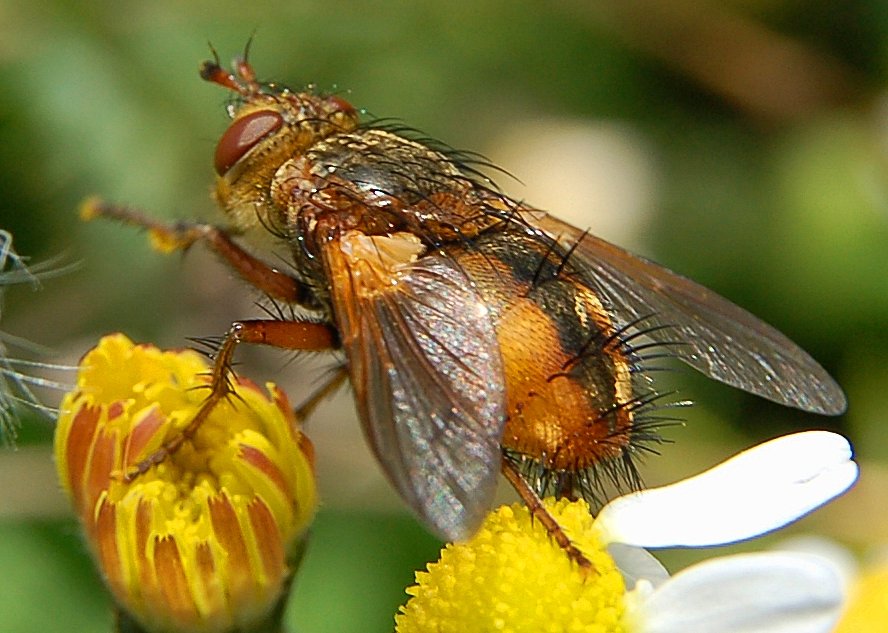
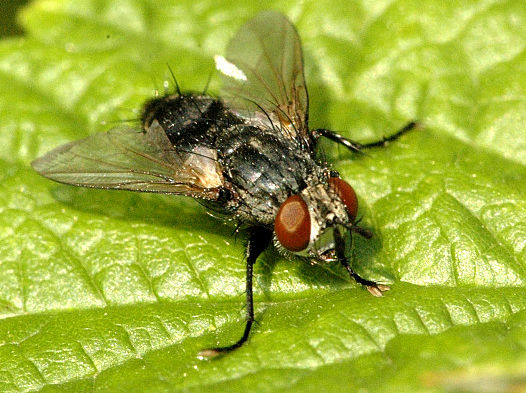
Conopid flies. Sicus ferrugineus mating pair Conops quadrifasciatus
Conopid flies often sit on flowers or foliage, waiting for a suitable bumblebee, wasp or solitary bee to fly past. When a potential host insect is detected, the female conopid will fly up and attempt to insert an egg into the abdomen of the host insect while in flight. As with tachinid flies, the conopid larva initially absorbs nutrients from the haemolymph but will later kill the host insect. Conopids overwinter as pupae inside the host insect’s corpse.
Calliphoridae: cluster flies. Cluster flies are members of the genus Pollenia, and although they look like bluebottles and house flies, they have no interest in our food and can't carry germs. They are parasitoids in earthworms.
Females lay eggs on soil near to earthworm burrows, and on hatching, the larvae find and enter the worms. There are about 20 species in Britain and Ireland, very hard to distinguish to species level.
Cluster flies only really come to our attention in the autumn, when aggregations of large numbers of adult flies appear mysteriously in out-of-the way corners of the house, often behind curtains in a window. They are seeking to overwinter and are attracted to group by pheromones released by early arrivers.
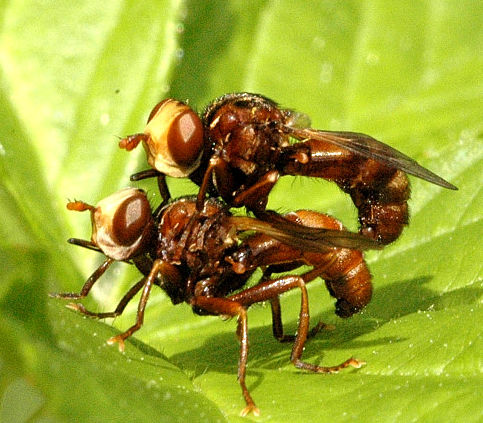
.jpg)
Tachinid flies found by Jennifer Owen. Top left:Tachina fera Top right: Epicampocera succincta
Left: Red tachinid fly Carcelia lucorum pupae in cocoons of ruby tiger moth.
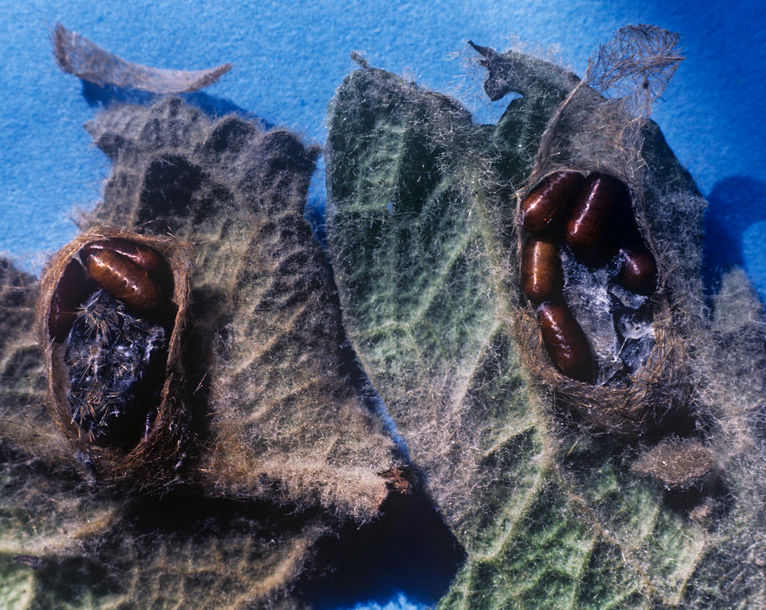
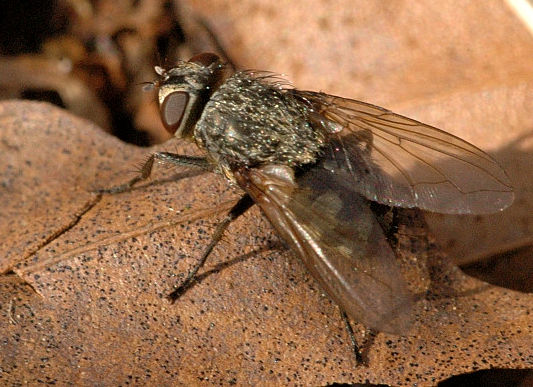
Common cluster fly Pollenia rudis
Role of parasitic flies in gardens
Parasitic flies are a useful part of a health garden ecosystem. Some of the insects targeted by tachinid flies are insects that gardeners often regard as pests, so some species can be considered to be beneficial. Conopid flies target bumblebees but are unlikely to kill enough bees to have a significant effect on their numbers. Both tachinid and conopid flies visit flowers, so they will be assisting with the pollination process.
Other sources of information
Websites
Website of the Tachinid Recording Scheme
Steve Falk's pages on conopid flies
Books
Belshaw, R. (1993) Handbooks for the Identification of British Insects Vol 10 part 4a(i). Tachinid Flies Diptera: Tachinidae. Royal Entomological Society
Smith, G. V. (1969) Handbooks for the Identification of British Insects Vol 10 part 3a. Diptera: Conopidae. – out of print but available here.
Page text drafted by Andrew Halstead, reviewed by Andrew Salisbury, compiled by Steve Head
|
|
|
|
|
|
Parasitic flies
What are commonly referred to as parasitic flies and wasps are more accurately called parasitoids. A true parasite feeds from a host animal without necessarily causing it any serious harm. A parasitoid often begins feeding as a parasite but as the larva develops it will ultimately kill the host animal. The other major parasitoid group in Britain and Ireland is the parasitic wasps.
Several fly families have larvae that are parasitoids. Flies in the Pipunculidae are parasitoids of leafhoppers and planthoppers; larvae of Acroceridae flies are parasitoids of spiders; Rhinophoridae flies are parasitoids of woodlice. These flies do occur in gardens but are unlikely to be noticed by people other than dipterists, so will not be considered further here. More noticeable are flies in the Tachinidae usually called tachinids, and the Conopidae, often called thick-headed flies. Both conopid flies and tachinid flies will visit flowers as adults to feed on nectar. There are also parasitic cluster flies in the Calliphoridae; other members of this family are discussed in our page on blow flies and houseflies.
Species in Britain and Ireland
Tachinidae With more than 250 species, the Tachinidae is easily the largest family of parasitoid flies in Britain and Ireland. Most tachinid flies are fairly nondescript greyish black, bristly flies, 2-20mm long, but some common species are more colourful such as the orange and black Tachina fera and Eriothrix rufomaculata. Jennifer Owen recorded two species of tachinid flies in her garden, which emerged from parasitised caterpillars.



Top: Tachinid flies found by Jennifer Owen. Top left:Tachina fera Top right: Epicampocera succincta
Left: Red tachinid fly Carcelia lucorum pupae in cocoons of ruby tiger moth.
Tachinid flies develop as larvae inside the bodies of their host animal, absorbing nutrients from the host’s haemolymph (insect ‘blood’) and fat bodies. Tachinid flies in their larval stages attack a wide range of other invertebrate animals. Most are associated with moth and butterfly caterpillars but other insects attacked include sawfly larvae, some adult or larval beetles, crane fly larvae (leatherjackets), earwigs and plant bugs (hemiptera). Centipedes are also attacked by some tachinids.
Eventually the host is killed and the parasitoid larva then consumes the remaining tissues. When the parasitoid is developing inside an insect larva, the end point often occurs when the caterpillar is nearly ready to pupate. Tachinid flies often overwinter as pupae but some overwinter as larvae inside their hosts.
Tachinid flies have various strategies for targeting their host animals. Some species attach eggs to the outside of the target insect, while others insert their eggs into the host insect’s body. Some tachinid fly species develop in insects that live in concealed situations, such as in the soil or under bark. These flies lay eggs in the places where the host animals are likely to occur. On hatching, the mobile larvae roam around until they find suitable hosts whose bodies they can invade. Other tachinid species deposit eggs on foliage. These eggs will not hatch unless the egg is ingested with leaf material by a host insect, such as a caterpillar.
Conopidae There are just over 20 species of conopid flies in Britain and Ireland and they are parasitoids of bumblebees, social wasps and some solitary bees. Jennifer Owen found 4 species in her garden. Some have wasp-like yellow and black banding on their bodies while others are reddish brown. They are 4-20mm long. Species likely to be seen in gardens include Sicus ferrugineus and some of the Conops and Myopa species. Some are widespread but most conopids are confined to southern England, but may move north with climate change.
Conopid flies have long extendable mouthparts that are kept folded under the head when not in use feeding on nectar. Myopa species are mainly active as adult flies in the spring, with most other conopids occurring in summer. Leopoldius signatus is an autumn species that visits ivy flowers and targets social wasps.

.jpg)
Conopid flies. Sicus ferrugineus mating pair Conops quadrifasciatus
Conopid flies often sit on flowers or foliage, waiting for a suitable bumblebee, wasp or solitary bee to fly past. When a potential host insect is detected, the female conopid will fly up and attempt to insert an egg into the abdomen of the host insect while in flight. As with tachinid flies, the conopid larva initially absorbs nutrients from the haemolymph but will later kill the host insect. Conopids overwinter as pupae inside the host insect’s corpse.
Calliphoridae: cluster flies. Cluster flies are members of the genus Pollenia, and although they look like bluebottles and house flies, they have no interest in our food and can't carry germs. They are parasitoids in earthworms.
Females lay eggs on soil near to earthworm burrows, and on hatching, the larvae find and enter the worms. There are about 20 species in Britain and Ireland, very hard to distinguish to species level.
Cluster flies only really come to our attention in the autumn, when aggregations of large numbers of adult flies appear mysteriously in out-of-the way corners of the house, often behind curtains in a window. They are seeking to overwinter and are attracted to group by pheromones released by early arrivers.

Common cluster fly Pollenia rudis
Role of parasitic flies in gardens
Parasitic flies are a useful part of a health garden ecosystem. Some of the insects targeted by tachinid flies are insects that gardeners often regard as pests, so some species can be considered to be beneficial. Conopid flies target bumblebees but are unlikely to kill enough bees to have a significant effect on their numbers. Both tachinid and conopid flies visit flowers, so they will be assisting with the pollination process.
Other sources of information
Websites
Website of the Tachinid Recording Scheme
Steve Falk's pages on conopid flies
Books
Belshaw, R. (1993) Handbooks for the Identification of British Insects Vol 10 part 4a(i). Tachinid Flies Diptera: Tachinidae. Royal Entomological Society
Smith, G. V. (1969) Handbooks for the Identification of British Insects Vol 10 part 3a. Diptera: Conopidae. – out of print but available here.
Page text drafted by Andrew Halstead, reviewed by Andrew Salisbury, compiled by Steve Head












